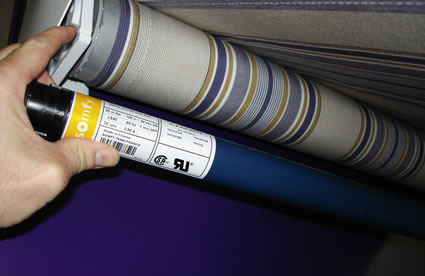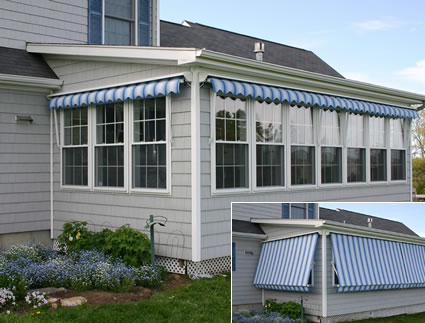Automation
Description
Just about any window attachment that is adjustable can be automated: shades, screens, awnings, shutters, and draperies. Automation includes motors, sensors, controls, and timers. Motors can raise-and-lower, tilt, or both. Both controls and power can be wireless, the former using radio frequency technology and the latter using battery technologies. Today’s window attachment motors and batteries are typically concealed and protected in the roller tubes of the attachment and operation of the newer motors is approaching “noiseless" operation.
Powering window attachments
There are three options for powering motorized attachments: battery (direct current or DC), outlet (may be DC or alternating current— AC), and inwall (AC). Battery power has the advantage of being wireless and not involving an electrician, but it is better suited to smaller or lighter window attachments. And even with long-life lithium batteries, periodic replacement is required (rechargeable batteries powered by a small solar photovoltaic panel are becoming available for exterior window attachments).
Outlet power is convenient because an electrician does not need to wire the attachment. In new construction, outlets can be concealed along the margin of the window or more typically up at the top of the window behind a valence or the head cassette of the attachment. “Fishing” of lighter gauge DC wiring is generally easier than larger-gauge AC wiring. DC motors (low voltage) require a transformer to step down and convert the AC house current. In general, DC motors are better suited to low to medium lift requirements.
Inwall power is AC house wiring direct to the motorized window attachment. Inwall power is best accomplished when wall cavities are open, during construction or major renovation. AC motors are well-suited to heavy lifting and can even service multiple window attachments.
Controlling motorized window coverings
When motorized window coverings are controlled by sensors, timers, or programs, the system is automated. Controls for motorized attachments can be either individual or grouped. Options include everything from battery-powered, hand-held remote control to mesh network, smart phone app-driven systems to full integration with a home's automation system. Programmable operation can be based on light intensity or temperature. Wind sensors can be included in exterior window attachment systems, which will then automatically retract when high winds threaten exterior attachments. Manufacturers of window attachment automation systems give detailed guidance on all the options and specifications for motors, power sources, and controls based on the type and size of window attachments.

New tubular motors like the one shown in this photo fit inside the axle tube around which the shades or awning is wrapped. These tubular motors are quite powerful, quiet, and durable. Tubular motors are capable of as much as 200 pounds of lift!
Photo: NuImage Robusta Awning by Futureguard, Auburn ME
Overall Thermal Performance
Each adjustable window attachment’s thermal performance can be improved by optimal operation. Several studies (see References) have shown significant improvement in both the thermal performance of adjustable window attachment operation as well as reduced lighting energy consumption when automation is employed. Savings can be achieved both from remote handheld user operation of motorized attachments asnd from automated operation employing sensor-activated window attachments.
Key Benefits
- Ease of operation, convenience
- Continued optimal operation during absence (security)
- Safety (no cords)
- Energy savings
Key Drawbacks
- Cost
- Learning curve for programming
- Size limitations
- Not available on all attachment types
Aesthetics
- Clean installation (hidden motors, no cords)
Tips/Cautions
- Batteries must be changed every 12 – 36 months (if battery-powered)
- Particularly for large exterior attachments, wind sensors are a good idea

This photo shows motorized awnings with retractable arms that permit the shade to fully deploy at
a 160 degree angle.
Photo: NuImage Robusta Awning by Futureguard, Auburn ME
When To Consider
- Need optimal operation during absences
- Operation needed for out-of-reach window attachments
- Need to eliminate cords (pets, children)
- Universal design
Appropriate/best-suited contexts:
- Changeable conditions/climates
- Hard-to-reach window coverings
- Need to change window covering position off-site
When to consider this retrofit—Ownership
| x | Homeowner |
| Apartment Renter - Long Term | |
| Apartment Renter - Short Term | |
| x | Live in a Condo* |
| x | Live in a Historical District* |
* Condominium regulations or historic building codes may require the use of higher VT and lower reflectance window films that maintain appearance from the outside.
Recommended Installer
| Do it Yourself | |
| Contractor | |
| x | Manufacturer or supplier |
Complementary Options
- Roller shades
- Cellular shades
- Awnings
- Blinds
- Draperies
Operation
- Various degrees of automated operation and control
Considerations
| 1 | 2 | 3 | 4 | 5 | |
| Ease of Installation (1 = easier) |
x (battery) | x | x | ||
| Availability (1 = more available) |
x | x | |||
| Cost (1 = lower cost) |
Representative Cost for a 30- by 60-inch Window
Motor and remote, NOT including installation
| Interior window covering | $200 |
| Exterior roller shade | $200 |
| Retractable awning or roller shutter | $300 |
Pricing automation for a single opening is challenging because automation includes a wide range of options or features and automation systems typically involve many or all window openings, not just a single window.
Digging Deeper
Energy Modeling Tools for Professionals
| RESFEN | |
| EnergyPlus-based modeling tools | |
| WINDOW 6 | |
| other |
